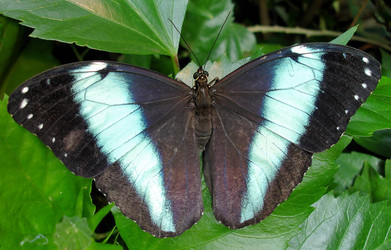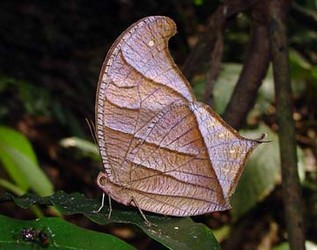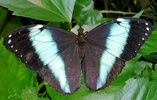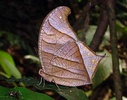Morphini
Niklas Wahlberg and Andrew V. Z. Brower


This tree diagram shows the relationships between several groups of organisms.
The root of the current tree connects the organisms featured in this tree to their containing group and the rest of the Tree of Life. The basal branching point in the tree represents the ancestor of the other groups in the tree. This ancestor diversified over time into several descendent subgroups, which are represented as internal nodes and terminal taxa to the right.

You can click on the root to travel down the Tree of Life all the way to the root of all Life, and you can click on the names of descendent subgroups to travel up the Tree of Life all the way to individual species.
For more information on ToL tree formatting, please see Interpreting the Tree or Classification. To learn more about phylogenetic trees, please visit our Phylogenetic Biology pages.
close boxIntroduction
A clade of three neotropical genera dwelling in forest understorey. The iconic "blue morphos," with iridescent scales on their wings that refract sunlight and flash as the butterflies fly along paths and stream courses, are among the world's largest and most beautiful butterflies.References
DeVries PJ, Kitching IJ, and Vane-Wright RI. 1985. The systematic position of Antirrhea and Caerois, with comments on the classification of the Nymphalidae (Lepidoptera). Syst. Ent. 10: 11-32.
Lamas G ed. 2004. Atlas of Neotropical Lepidoptera. Checklist: Part 4A Hesperioidea - Papiionoidea. Gainesville: Scientific Publishers/Association of Tropical Lepidoptera.
Penz CM, and DeVries PJ. 2002. Phylogenetic analysis of Morpho butterfles (Nymphalidae, Morphinae): implications for classification and natural history. Amer. Mus. Novitates 3374: 1-33.
Pena C, Wahlberg N, Weingartner E, Kodandaramaiah U, Nylin S, Freitas AVL, and Brower AVZ. 2006. Higher level phylogeny of Satyrinae butterflies (Lepidoptera: Nymphalidae) based on DNA sequence data. Mol. Phylogenet. Evol. 40: 29-49.
Title Illustrations

| Scientific Name | Morpho achilles |
|---|---|
| Location | Butterfly house, Vienna, Austria; native to South and Central America |
| Specimen Condition | Live Specimen |
| Source | Morpho achilles |
| Source Collection | Flickr |
| Image Use |
 This media file is licensed under the Creative Commons Attribution-NonCommercial-ShareAlike License - Version 2.0. This media file is licensed under the Creative Commons Attribution-NonCommercial-ShareAlike License - Version 2.0.
|
| Copyright | © 2006 Gertrud Kanu |
| Scientific Name | Caerois chorinaeus |
|---|---|
| Location | Brazil: Mato Grosso, Rio Cristalino Lodge |
| Specimen Condition | Live Specimen |
| Life Cycle Stage | adult |
| View | ventral |
| Source | Chorinaeus Morpho (Caerois chorinaeus ) |
| Source Collection | Neotropical Butterflies |
| Copyright | © 2003 Will Carter |
About This Page
Niklas Wahlberg

University of Turku, Finland

Middle Tennessee State University, Murfreesboro, Tennessee, USA
Correspondence regarding this page should be directed to Niklas Wahlberg at and Andrew V. Z. Brower at
Page copyright © 2010 Niklas Wahlberg and
 Page: Tree of Life
Morphini .
Authored by
Niklas Wahlberg and Andrew V. Z. Brower.
The TEXT of this page is licensed under the
Creative Commons Attribution License - Version 3.0. Note that images and other media
featured on this page are each governed by their own license, and they may or may not be available
for reuse. Click on an image or a media link to access the media data window, which provides the
relevant licensing information. For the general terms and conditions of ToL material reuse and
redistribution, please see the Tree of Life Copyright
Policies.
Page: Tree of Life
Morphini .
Authored by
Niklas Wahlberg and Andrew V. Z. Brower.
The TEXT of this page is licensed under the
Creative Commons Attribution License - Version 3.0. Note that images and other media
featured on this page are each governed by their own license, and they may or may not be available
for reuse. Click on an image or a media link to access the media data window, which provides the
relevant licensing information. For the general terms and conditions of ToL material reuse and
redistribution, please see the Tree of Life Copyright
Policies.
- First online 25 September 2006
- Content changed 12 February 2010
Citing this page:
Wahlberg, Niklas and Andrew V. Z. Brower. 2010. Morphini . Version 12 February 2010 (under construction). http://tolweb.org/Morphini/70272/2010.02.12 in The Tree of Life Web Project, http://tolweb.org/









 Go to quick links
Go to quick search
Go to navigation for this section of the ToL site
Go to detailed links for the ToL site
Go to quick links
Go to quick search
Go to navigation for this section of the ToL site
Go to detailed links for the ToL site